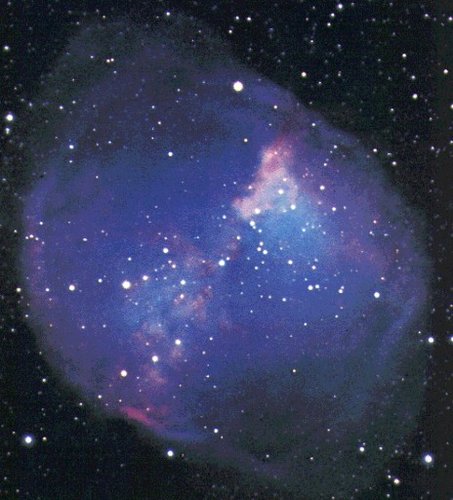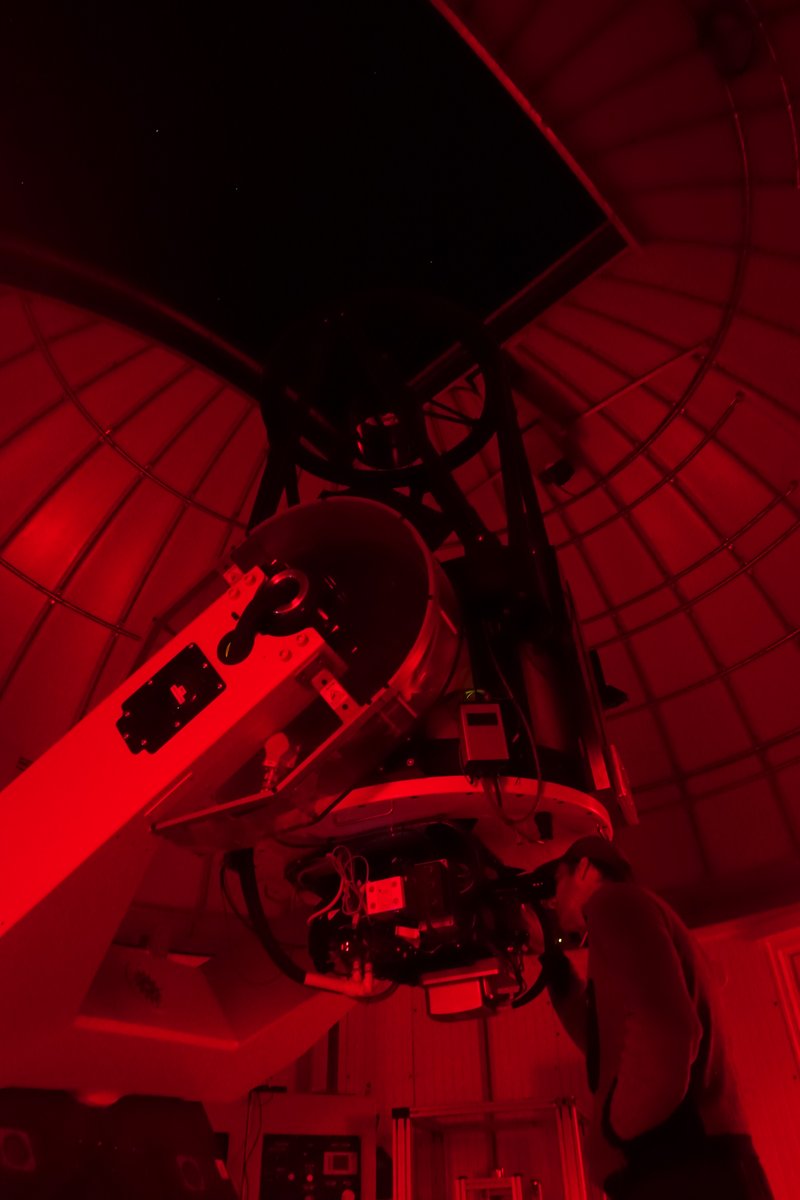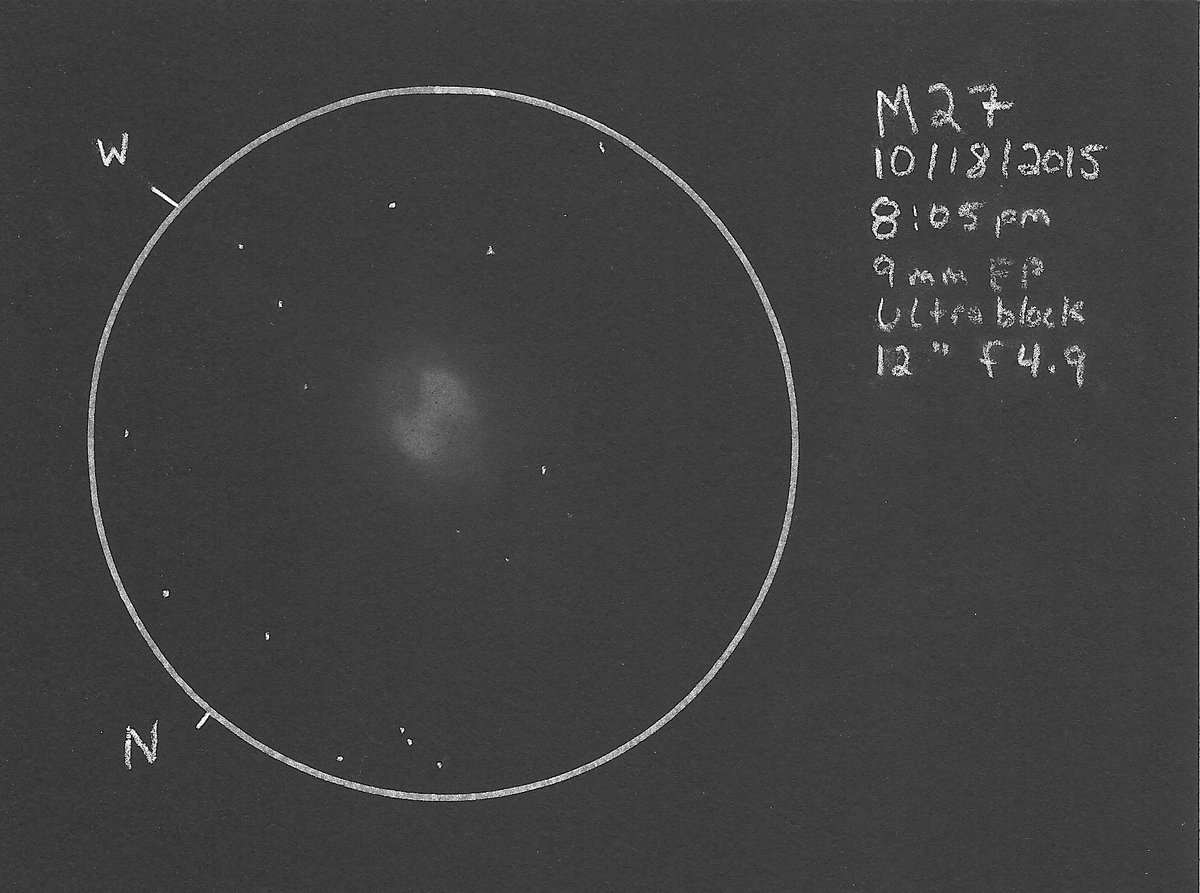Current Info for Observer
as of 07/27/2024 8:30 a.m.
Please login to view current observation details
General Info
| Type | Planetary Nebula |
| Constellation | Vulpecula |
| Right ascension | 19h59'36.300'' |
| Declination | +22°43'17'' |
| Magnitude | 7.400 |
| Distance | 1,250ly |
| Size | 8 arc min |
| Catalog Designations | NGC6853, M27 |
| Discovered | 1764 Charles Messier |
Generate a finder chart
The following form will generate a PDF finder chart suitable for printing using to locate objects in the sky with your telescope!
The Date is only really useful for solar system objects, as deep space objects move measurably only on a galactic timescale.
The larger the F.O.V (field of view), the more "zoomed out" the object will appear. It can be helpful to print several charts of the same object with different field of views.
Limiting the magnitude (remember, lower magnitude means brighter!) of stars and objects can make sure your chart is not cluttered with dim objects that you may not be visible to you anyway. The defaults are good, but try experimenting with raising and lowering the values.
Seestar S50
20 points
M27, également connue sous le nom de nébuleuse du Dumbbell, est une nébuleuse planétaire située dans la constellation du Petit Renard (Vulpecula). Elle a été découverte en 1764 par l'astronome français Charles Messier. M27 est un objet céleste fascinant à observer en raison de sa forme distinctive qui ressemble à une haltère ou à une toupie.
Voici quelques caractéristiques générales de M27 :
Nom de l'objet : M27 (Nébuleuse du Dumbbell) Date et heure : 11 mai 2024 à 00h44 (heure locale à Laval, Québec, Canada) Lieu : Laval, Québec, Canada Conditions météorologiques : Ciel clair et sans lune sont préférables pour une observation optimale. Instrument : Seestar S50 Type d'objet : Nébuleuse planétaire Dimension : Moyenne à grande par rapport au champ de vision de l'instrument Bords de l'objet : Nets Forme de l'objet : Haltère ou toupie Couleur de l'objet : Généralement vert pâle Densité : Moyenne à faible Nombre d'étoiles estimé : Difficile à estimer sans observations spécifiques Apparence : Centre plus brillant, Annulaire Éclat global : Moyen à brillant Réponse au filtre : Moyenne à forte, en utilisant des filtres appropriés comme un filtre OIII pour augmenter le contraste. Appréciation personnelle : M27 est souvent considérée comme un objet remarquable pour les observateurs du ciel en raison de sa forme distincte et de son éclat. Son observation peut varier en fonction de la qualité de l'équipement et des conditions d'observation, mais elle est généralement considérée comme un très bel objet à observer.
M27, also known as the Dumbbell Nebula, is a planetary nebula located in the constellation of Vulpecula, the Little Fox. It was discovered in 1764 by the French astronomer Charles Messier. M27 is a fascinating celestial object to observe due to its distinctive shape resembling a dumbbell or a spinning top.
Here are some general characteristics of M27 :
Object Name: M27 (Dumbbell Nebula) Date and Time: May 11, 2024, at 00:44 (local time in Laval, Quebec, Canada) Location: Laval, Quebec, Canada Weather Conditions: Clear sky and moonless conditions are preferable for optimal observation. Instrument: Seestar S50 Object Type: Planetary Nebula Size: Medium to large compared to the instrument's field of view Object Edges: Sharp Object Shape: Dumbbell or spinning top Object Color: Generally pale green Density: Medium to low Estimated Star Count: Difficult to estimate without specific observations Appearance: Brighter center, Annular Overall Brightness: Medium to bright Filter Response: Medium to strong, using appropriate filters such as an OIII filter to enhance contrast. Personal Appreciation: M27 is often regarded as a remarkable object for sky observers due to its distinct shape and brightness. Its observation can vary depending on equipment quality and observing conditions, but it is generally considered a very beautiful object to observe."
LCOGT 1Meter Scope - Sinistro
20 points
We went on a mission up to Sedgwick with a group of friends and coworkers. OK conditions but the .8 meter provided good views as usual.
This was the first time I got a good look at the dumbbell Nebula. Larger than I expected, has a peculiar bow-tie shape to it. Near Zenith this time of year so the bad seeing near the horizon was lessened here. Very cool object.
10" Dobsonian
20 points
XX12i
0 points
Revisited to check the OIII filter on M27. It works wonderfully well on this object! The football shape elongated nebula surrounding the central 'apple core' is very visible with the OIII and the central apple core shows more detail with the OIII. Overall this object looks better with the OIII over the Ultrablock. M27 is another good outreach object, and with the OIII it is a great view even for first-timer observers.
Please login to post comments



